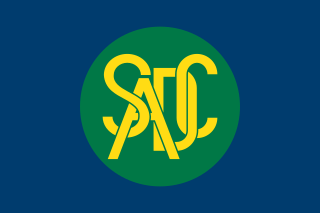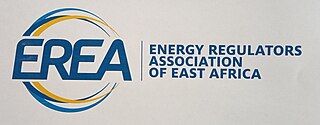International judicial institutions can be divided into courts, arbitral tribunals and quasi-judicial institutions. Courts are permanent bodies, with near the same composition for each case. Arbitral tribunals, by contrast, are constituted anew for each case. Both courts and arbitral tribunals can make binding decisions. Quasi-judicial institutions, by contrast, make rulings on cases, but these rulings are not in themselves legally binding; the main example is the individual complaints mechanisms available under the various UN human rights treaties.

The Southern African Development Community (SADC) is an inter-governmental organization headquartered in Gaborone, Botswana.

The East African Community (EAC) is an intergovernmental organisation composed of eight countries in East Africa. The member states are the Democratic Republic of the Congo, the Federal Republic of Somalia, the republics of Burundi, Kenya, Rwanda, South Sudan, Uganda and Tanzania. Salva Kiir Mayardit, the president of South Sudan, is the current EAC chairman. The organisation was founded in 1967, collapsed in 1977, and was revived on 7 July 2000.

The Caribbean Court of Justice is the judicial institution of the Caribbean Community (CARICOM). Established in 2005, it is based in Port of Spain, Trinidad and Tobago.

The African Central Bank (ACB) is one of the original five financial institutions and specialized agencies of the African Union. Over time, it will take over responsibilities of the African Monetary Fund.

The African Economic Community (AEC) is an organization of African Union states establishing grounds for mutual economic development among the majority of African states. The stated goals of the organization include the creation of free trade areas, customs unions, a single market, a central bank, and a common currency thus establishing an economic and monetary union.

The Economic Community of Central African States is an Economic Community of the African Union for promotion of regional economic co-operation in Central Africa. It "aims to achieve collective autonomy, raise the standard of living of its populations and maintain economic stability through harmonious cooperation".
The East African Court of Justice (EACJ) is a treaty-based judicial body of the East African Community tasked to ensure adherence to law in the interpretation and application of and compliance with the East African Community Treaty of 1999. The Court is made up of two divisions: a First Instance Division and an Appellate Division. Its Judges, a maximum of ten in the First Instance Division and of five in the Appellate Division, are appointed by the East African Community Summit, the highest organ of the community, from among persons recommended by the Partner States who are of proven integrity, impartiality and independence and fulfill the conditions required in their own countries for high judicial office, or are jurists of recognised competence.

The African Monetary Union (AMU) is the proposed creation of an economic and monetary union for the countries of the African Union, administered by the African Central Bank. Such a union would call for the creation of a new unified currency, similar to the euro; the hypothetical currency is sometimes referred to as the afro or afriq. The single African currency is to be composed of currency units made up of regional union reserve bank currency units of which are made up country specific currencies.
The Regional Economic Communities (RECs) in Africa group together individual countries in subregions for the purposes of achieving greater economic integration. They are described as the "building blocks" of the African Union and are also central to the strategy for implementing the New Partnership for Africa's Development (NEPAD).

The African Free Trade Zone (AFTZ) is a free trade zone announced at the EAC-SADC-COMESA Summit on 22 October 2008 by the heads of Southern African Development Community (SADC), the Common Market for Eastern and Southern Africa (COMESA) and the East African Community (EAC). The African Free Trade Zone is also referred to as the African Free Trade Area in some official documents and press releases.
The Trade and Development Bank (TDB), formerly the PTA Bank, is a trade and development financial institution operating in eastern and southern Africa. TDB is the financial arm of the Common Market for Eastern and Southern Africa (COMESA), although membership is open to non-COMESA states and other institutional shareholders.
The Panel of the Wise (PoW) is a consultative body of the African Union, composed of five appointed members who each serve three year terms. Its mandate is to provide opinions to the Peace and Security Council on issues relevant to conflict prevention, management, and resolution. Representatives are chosen for the North, East, South, West, and Central regions of the continent.

A customs and monetary union is a type of trade bloc which is composed of a customs union and a currency union. The participant countries have both common external trade policy and share a single currency.

The SADC Tribunal was a court and the highest policy institution of the Southern African Development Community (SADC). It was housed in the Turnhalle building in Windhoek, the capital of Namibia. Although established on paper since 1992, members of the Tribunal were only appointed during the SADC Summit in 2005. On 18 November 2005 the Tribunal was inaugurated and the members were sworn in by Peter Shivute, chief justice of Namibia of the Namibian Supreme Court.
Sindiso Ndema Ngwenya, is a Zimbabwean economist and transportation expert. He was the Secretary General of the Common Market for Eastern and Southern Africa (COMESA). Prior to that, he served as the Assistant Secretary General of COMESA in charge of Programmes, from 1998 until 2008.
The Tripartite Free Trade Area (TFTA) is a proposed African free trade agreement between the Common Market for Eastern and Southern Africa (COMESA), Southern African Development Community (SADC) and East African Community (EAC).

The Energy Regulators Association of East Africa (EREA) is a non-profit organisation mandated to spearhead harmonisation of energy regulatory frameworks, sustainable capacity building and information sharing among the List of energy regulatory bodies in the East African Community. Its key objective is to promote the independence of national regulators and support the establishment of a robust East African energy union.

Peter Mutuku Mathuki is a Kenyan diplomat, private sector development expert and politician who served as the 6th and current Secretary General of the East African Community. he previously served as an MP in the East African Legislative Assembly between 2012 and 2017 and executive director of the East African Business Council from 2018 to 2021. He was appointed Secretary General by the East African Community Heads of State on 27 February 2021.












